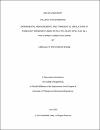EXPERIMENTAL MEASUREMENTS AND TRANSIENT 3D SIMULATIONS OF TURBULENT PREMIXED FLAMES OF GAS-TO-LIQUIDS (GTL) FUEL IN A FAN-STIRRED COMBUSTION BOMB
| Advisor | Sleiti, Ahmad |
| Advisor | Ahmed, Samer |
| Author | SADEQ, ABDELLATIF MOHAMMAD |
| Available date | 2022-08-31T09:27:16Z |
| Publication Date | 2022-06 |
| Abstract | The rapid fluctuation in oil prices and the increased demand for alternative fuels to replace conventional fuels are challenging contemporary issues. One such alternative fuel that has gained significant interest recently is the Gas-to-Liquids (GTL) fuel, which is in the stage of replacing conventional diesel. However, detailed combustion characteristic investigations are required before using this alternative fuel broadly in engines. Therefore, the present dissertation is dedicated to experimentally investigate GTL (and its 50/50 by volume blend with diesel) turbulent flame speeds (St) under a wide range of thermodynamics and turbulence operating conditions using a cylindrical fan-stirred combustion bomb. Turbulent premixed GTL flame is centrally ignited in an 81.7L cylindrical combustion bomb under atmospheric pressure at an initial temperature of 463K near Homogeneous and Isotropic Turbulence (HIT) conditions. The experiments are conducted under a wide range of equivalence ratios (Ф) between 0.7 to 1.3 and turbulence intensities (u`) that vary between 0.5m/s and 3.0m/s at an integral length scale, Lt=20mm. The turbulent flame speed of the outwardly propagating GTL flame is measured using a pressure transducer, and the flame propagation is visualized by high-speed imaging. To extend and verify the experimental findings, Zimont Turbulent Flame Speed Closure (Zimont TFC) numerical model is adapted and implemented into ANSYS Fluent through a Reynolds Averaged Navier-Stokes (RANS) approach to study the influence of turbulence on GTL premixed combustion. The results showed that: (i) rich diesel and lean GTL fuels are characterized by faster flame development and pressure rise rate (dp/dt) and thus, higher turbulent flame speeds; (ii) at the same elapsed time, turbulent Reynolds numbers (ReT) and Damkohler numbers (Da) are higher for stoichiometric GTL fuel compared to diesel and 50/50 diesel-GTL blend, which indicates that the flame propagates towards the vessel’s wall at a faster rate, and the chemistry has dominated turbulence in a shorter time, and (iii) at low turbulence intensity level (u`=0.5m/s), the flame morphology is defined by a wrinkled flamelet regime in Borghi diagram. However, at moderate and high turbulence levels (u`=1.5m/s and u`=3.0m/s, respectively), the corrugated flamelets regime defines the flame structure. |
| Language | en |
| Subject | Gas-to-Liquids (GTL) replacing conventional diesel |
| Type | Dissertation |
| Department | Mechanical Engineering |
Files in this item
This item appears in the following Collection(s)
-
Mechanical Engineering [58 items ]


